|
|
|
Sort Order |
|
|
|
Items / Page
|
|
|
|
|
|
|
| Srl | Item |
| 1 |
ID:
192168
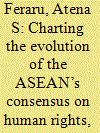

|
|
|
|
|
| Summary/Abstract |
This article provides a comprehensive understanding of the roles and functions of ASEAN’s human rights regime by building on widely documented, consistent findings relating to the purpose of the association and the nature of its human rights institutions. In particular, the paper starts by emphasizing that, despite continuing debate over the nature and achievements/failures of the regional grouping, scholarship tends to converge on the two important aspects: ASEAN’s normative framework and its long-standing practice of ‘quiet diplomacy’ are designed to reassure incumbent governments weary of unwanted interference in internal affairs; and regional human rights institutions are primarily ASEAN bodies. These findings are formulated as assumptions guiding the analysis of the association’s human rights rhetoric and practice, which centers on the evolution of intergovernmental consensus, the role of the ASEAN Intergovernmental Commission on Human Rights (AICHR) in advancing this consensus, and an assessment of ASEAN responses to gross violations perpetrated or supported by governing elites. This latter examination details regional responses to the 2014 military coup in Thailand, Philippines’ brutal and largely extrajudicial ‘war on drugs’, the Rohingya genocide, and the 2021 military coup in Myanmar and ensuing violence.
|
|
|
|
|
|
|
|
|
|
|
|
|
|
|
|
| 2 |
ID:
192174
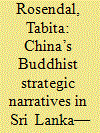

|
|
|
|
|
| Summary/Abstract |
While the economic impact of China’s ‘Belt and Road’ Initiative (BRI) in Sri Lanka has been closely monitored in recent years, few studies have focused on the role of China’s Buddhist narratives in furthering the countries’ interests. By analyzing the Buddhist strategic narratives used in official Chinese and Sri Lankan statements, this article argues that under the BRI’s ‘people-to-people’ bonds, Chinese and Sri Lankan officials have used the Buddhist history and exchanges between the two nations to advocate for BRI projects, and to strengthen their cultural ties. This article finds, more narrowly, that China’s Buddhist diplomacy in Sri Lanka has increased since the BRI’s inception, and that it has focused on enhancing bilateral relations and mitigating criticism of projects. China’s strategic narratives have been somewhat successful, but since they are employed alongside economic investments, their precise impact is difficult to measure. More broadly, the CCP is increasingly positioning itself and the BRI through religious strategic narratives to mitigate criticism and further its interests and stature in the international system. However, while China’s projection of Buddhist strategic narratives, in tandem with infrastructure investments, may ensure the BRI’s continued implementation, this depends on the willingness of host countries of accepting these narratives.
|
|
|
|
|
|
|
|
|
|
|
|
|
|
|
|
| 3 |
ID:
192167
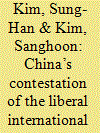

|
|
|
|
|
| Summary/Abstract |
The concept of ‘revisionism’ has caught the attention of international relations scholars amid intensifying rivalry between the United States and China. It is a trademark of rising powers, and China was likewise expected to become a revisionist power, intent on changing the status quo. However, history tells us that not all rising powers necessarily become revolutionary states, seeking to overturn the prevailing order and replace it with another through hegemonic wars. This paper presents a novel understanding of revisionism by distinguishing between strategic ‘contestation’ and ‘challenge’. In the context of declining unipolarity, a dissatisfied rising power will contest the rules and principles of issue-specific regimes and demand legitimate adjustments that better reflect the new distribution of power. A challenge emerges when demands are rejected, and a contestation leads to ‘deconcentration’ and ‘delegitimation’ of the established order. The establishment of the AIIB can be examined as an example of contested multilateralism that falls short of a challenge. This paper concludes that China is ‘contesting’, not ‘challenging’ the liberal international order and suggests a set of countermeasures that the U.S. can think of: selective accommodation, reinforcement of alliances and partnerships, and overcoming domestic challenges such as populism that undermine the liberal values, constitutive of the liberal international order.
|
|
|
|
|
|
|
|
|
|
|
|
|
|
|
|
| 4 |
ID:
192172


|
|
|
|
|
| Summary/Abstract |
This study examines the integration of cybersecurity within the U.S.-Philippine alliance. The growth of new forms of international conflict, like cybersecurity, occur below the threshold of a traditional armed attack and pose a direct challenge to security alliances designed to rebuff conventional military threats. Using a process-tracing approach, this article investigates the evolution of cybersecurity within the U.S.-Philippine relationship and how it has met this new challenge. It finds that despite mutual concern over cybersecurity, divergent approaches to the digital domain as a policy area has stymied alliance development. This finding highlights how issues like elite political discord, different threat perceptions, and divergent institutional preferences can hinder cyber cooperation between partners and stymie alliance development.
|
|
|
|
|
|
|
|
|
|
|
|
|
|
|
|
| 5 |
ID:
192171


|
|
|
|
|
| Summary/Abstract |
Indigenous peoples in Southeast Asia have organized on issues that affect their rights at the local, national, regional and global level. This article argues that one important component of the rise of this activism is the presence of regional scalar bridging organizations that link activism across scales and support the growth of Indigenous movements by providing access to global and regional opportunities for action. In Southeast Asia, the Asian Indigenous Peoples Pact (AIPP) and Tebtebba play this role through their presence in global political arenas and their many activities with partner organizations in the region. Drawing on social movement theory, this article outlines how regional social movement organizations potentially support global activism in the Global South by scale bridging in the areas of (1) resource mobilization, (2) creation of political spaces and opportunities and (3) the diffusion of ideas. To illustrate this, the case of Indigenous peoples activism on climate change in Southeast Asia is presented through an examination of the work done in these three areas by the Asian Indigenous Peoples Pact (AIPP) and Tebtebba
|
|
|
|
|
|
|
|
|
|
|
|
|
|
|
|
| 6 |
ID:
192170
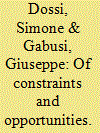

|
|
|
|
|
| Summary/Abstract |
This article argues that a peculiar pattern of dependent asymmetry – ‘dual dependence’, i.e. a combination of internal and external dependence – has come to characterize the structure of China-Myanmar relations since the late 1980s. The hypothesis we present is that shifts in this pattern of dependent asymmetry account for fluctuations in China-Myanmar relations between 2011 and 2021. We test this hypothesis against empirical evidence from what we identify as two shifts in the structure of bilateral relations: for each, we trace how structural changes were perceived in Naypyitaw and Beijing, and how such perceptions oriented an adjustment in their respective policies. Myanmar’s reduced external dependence on China in 2011–2012 expanded the set of the potential courses of action available to Myanmar’s decision-makers and reduced the set of those available to China; conversely, the opposite happened in 2017–2018, following Myanmar’s return to full-fledged external dependence on China. The paper finally speculates that the military coup in 2021 could well represent a third shift in the structure of bilateral relations, further strengthening Myanmar’s external dependence on China and constraining the military government’s room of manoeuvre.
|
|
|
|
|
|
|
|
|
|
|
|
|
|
|
|
| 7 |
ID:
192173
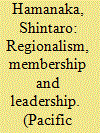

|
|
|
|
|
| Summary/Abstract |
Drawing inspiration from a Chinese proberb, this paper offers an alternative interpretation of regionalism, with a special reference to its membership. This alternative interpretation provides insights into the exclusionary aspect of regionalism, for which mainstream international relations theories lack a certain efficacy in providing plausible explanations. We hypothesize that a state forms a regional group in which it can be a leader, excluding states that are more powerful than it is. A state values the leading position in a regional group, even in a small regional group. To test the hypothesis, this paper investigates regionalism launched in Asia during the second half of 20th century, with special attention to the inclusion and exclusion of the US. By analyzing diplomatic records obtained at four national archives (Australia, Japan, the UK, and the US), as well as memoirs by retired officials and other studies, this paper shows that regionalism in Asia was often pursued in an exclusionary manner, mainly by Japan, and to a lesser degree by Indonesia. The paper also discusses whether and how regionalism in Europe can be explained with this alternative theory.
|
|
|
|
|
|
|
|
|
|
|
|
|
|
|
|
| 8 |
ID:
192166


|
|
|
|
|
| Summary/Abstract |
This essay unpacks the hedging behavior of small and secondary states by focusing on Southeast Asian responses to the intense US-China rivalry and the emergence of the Quadrilateral Security Dialogue (Quad) in the Indo-Pacific region. It contends that the weaker states’ perceptions of external realities are not black and white, but shades of grey, as uncertainty breeds ambiguity and ambivalence. The states often do not view a major power (and its initiatives) as either a clear-cut threat or a straightforward solution. Instead, they perceive a spectrum of risks and challenges, each with constantly changing manifestations and magnitude, all of which require complex combinations of mutually-reinforcing and counteracting measures. All ASEAN states have mixed attitudes towards the competing powers, viewing both the Quad’s Free and Open Indo-Pacific (FOIP) strategies and China’s Belt and Road Initiative (BRI) as bringing not only opportunities but also risks and dangers. These ambivalent perceptions entail a process of ‘riskification’, where states identify and prioritize certain risks while downplaying others, in ways that serve elite interests at home. Hence, while nearly all the ASEAN states have stressed in varying degrees the risks of entrapment, abandonment, polarization and marginalization, many have downplayed the dangers of big-power aggressiveness and interference, some more so than others. The varying riskification patterns thus lead to varying hedging acts, prompting subtly different responses to the emerging realities.
|
|
|
|
|
|
|
|
|
|
|
|
|
|
|
|
| 9 |
ID:
192169
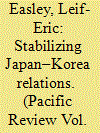

|
|
|
|
|
| Summary/Abstract |
By the time Prime Minister Abe Shinzo and President Park Geun-hye took office, Japan-South Korea relations were already experiencing a downturn over history issues and Lee Myung-bak’s unprecedented presidential visit to the disputed islets of Dokdo/Takeshima. Park’s refusal to hold a bilateral summit became the symbol of strained ties. Then on November 2, 2015 — 980 days after taking office — Park met Abe for bilateral talks in Seoul. On December 28, the two sides declared a rapprochement with an agreement supporting survivors of wartime brothels. Tensions worsened again during President Moon Jae-in’s term (2017–2022), contradicting the narrative that leaders had turned relations around in late 2015. Yet the diplomatic relationship was not on a downward spiral. Japanese and Korean policymakers managed to put a floor under their interactions owing to three stabilizing mechanisms that operated during both the Park and Moon administrations. First, political elites practiced mutual restraint to limit vicious cycles of nationalist recriminations. Second, Tokyo and Seoul carefully calibrated policies toward Beijing while avoiding divergence from each other. Third, reassuring the United States about the cost-effectiveness of its alliances involved trilateral cooperation that also helped stabilize Japan-South Korea relations.
|
|
|
|
|
|
|
|
|
|
|
|
|
|
|
|
|
|
|
|
|